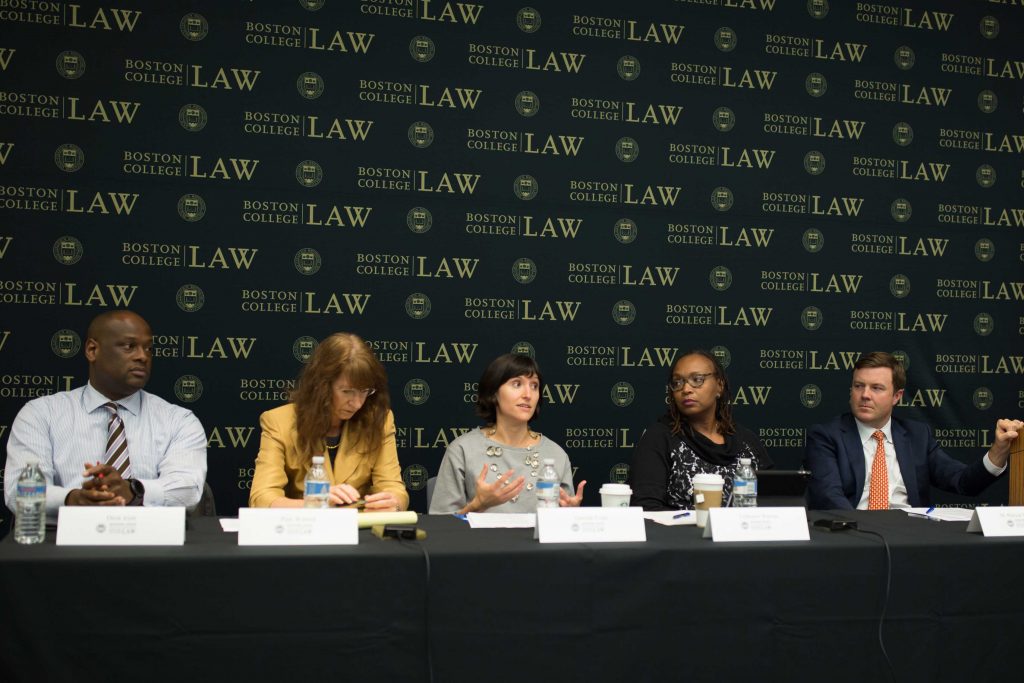What’s next in voting rights? At the Rappaport Center for Law and Public Policy’s event September 26, a panel of experts offered answers to this ever-relevant question.
Moderator M. Patrick Moore Jr. ’07, counsel at Hemenway & Barnes and former associate counsel and advisor for presidential personnel under President Barack Obama, began with the observation that there is a “unique lack of confidence in major institutions that is particularly true for civic institutions. For better or worse,” he said, “voting is a state and local issue.”
Accordingly, the conversation focused on voting initiatives at the state and local level and how the federal government can support those efforts.
The audience first heard from LaShawn Warren, senior vice president of campaigns and programs at the Leadership Conference on Civil and Human Rights. She discussed Shelby County v. Holder, the 2013 Supreme Court case that struck down a section of the Voting Rights Act that determines which voter jurisdictions are subject to government preclearance based on a history of racial discrimination.
“Sixty-one cases have been filed post-Shelby, and only four of those were from the Department of Justice; the others were brought by private citizens,” Warren said. “The Department of Justice is not enforcing the VRA as vigorously as they possibly could. We need a robust effort from members of Congress who are really interested in fortifying our democratic process by passing legislation that has to do with voting.”
Hannah Fried, the co-founder and executive director of Access Democracy, identified the need for new tools in the voting rights toolkit. “The protections once available to us, particularly in the Deep South, aren’t available anymore,” she said. “We are increasingly recognizing how much power lives with state and local election officials. The sooner you appreciate that, the faster you will become a really great advocate.”
Pam Wilmot built off this point, describing the state level as an ideal sphere for public policy changes. Wilmot is the director of Common Cause Massachusetts, a nonprofit that promotes reform to state campaign finance, ethics, and election laws. She emphasized three primary goals of voting reform: first, to make laws accessible; second, to make voting convenient; and third, to make it secure. “If you have one polling place for 600,000 people, it’s not going to be very easy,” Wilmot said.
Dion Irish, the chairman of the Boston Election Commission, drew laughter from the audience when he said that they were pleased by the 25 percent turnout for the state primary on September 4. “Everyone was ecstatic about that, because we expected a much lower turnout,” he explained. Irish also envisioned three goals to improve voting rights. First, governments should work to heighten public confidence by ensuring security at the polls and preventing misinformation about logistics. Second, voter access is crucial to bringing elections “out of the ice age.” To this end, Irish proposed voting by mail as a cost-effective option, creating vote centers where people could drop off their ballots, making same-day registration easier, and educating students about the voting process. Third, voting institutions should be modernized to make it easier for citizens to remain active voters.
Moore then led a question and answer session. He asked the panelists what key municipal and local decisions influence the smooth operation of Election Day. Irish named two: locating and securing polling places a year ahead of time, and training poll workers to administer the laws properly.
Fried added that election officials need adequate information and resources to be advocates for the voting process. “In 2016, more than a million people across the country didn’t vote because lines were too long, or they thought they registered and they didn’t,” she said.
Wilmot urged the audience to look into Election Protection, a bipartisan initiative that recruits people to observe the polls and call in if problems arise.
The panelists also addressed discrimination, which continues to stymie voting rights.
Warren told the story of “Mrs. Hutchins,” a 90-year-old African American woman whose birth was only recorded in her family’s bible. “She registered to vote and never missed an election. Then Milwaukee passed a Voter ID law, and she can no longer vote,” Warren said. Irish argued that voting policies should be tested to ensure that “there is no disparate impact along racial lines and disability lines.”
One audience member asked whether the government could use the Voting Rights Act to bail in, or automatically pre-clear, jurisdictions with histories of discrimination. Fried explained that it is difficult to measure the intent and impact of voting laws without close oversight. “The ability of a state to empower independent commissions is hanging by one Supreme Court vote,” Moore added. “There is the potential for backsliding that is very real.”
Finally, Moore asked how we could talk about the goal of broader voter access in a way that bridges partisanship.
The panelists suggested that people set aside politics and see voting rights issues through the prism of fairness, equity, and the civic duty to vote. “Those are values that we can all hang our hat on,” Fried explained. Wilmot added that everyone is concerned about voter fraud and that there are ways of talking about these issues that resonate with both Republicans and Democrats.
Warren pointed out that every time the Voting Rights Act was reauthorized, it was a Republican president who signed it. “I have seen people come together and put their partisanship aside. I say that to give an ounce of hope to people.”
In closing remarks, Fried advocated for a shift in language when it comes to conversations about voting rights. “I actually talk less and less about voter suppression and more and more about voter participation and engagement,” she said. “What helps people is feeling confident.”
Photograph, left to right: Dion Irish, Pam Wilmot, Hannah Fried, LaShawn Warren, M. Patrick Moore Jr. ’07


